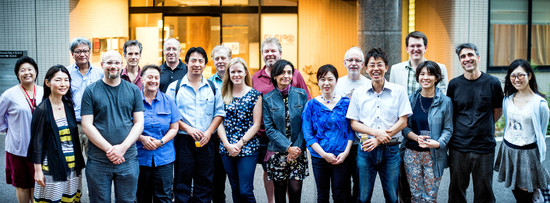ELSI Blog
111 A Strategy for Origins of Life Research
What do you do when twin typhoons seem to be bearing down on the first ELSI Origins Network (EON) workshop to be held at ELSI itself?
You carry on of course.
And, in this case, the inherent variability of Earth's wonderfully non-linear meteorological systems ended up favoring the 38 attendees who came to review and discuss the state-of-the-art in origins of life science (OoL). From August 26th to 28th 2015, not only did an extraordinarily lively and productive meeting unfurl, the typhoons ended up leaving Tokyo with a little rain and pleasantly cooler temperatures. As one of EON's Global Science Coordinators it was my privilege to chair the meeting. Our timing also allowed NASA's senior scientist for astrobiology, and head of NASA's astrobiology effort, Dr. Mary Voytek to attend in her role as another EON Global Science Coordinator, bringing an invaluable perspective to the proceedings.
As one of EON's Global Science Coordinators it was my privilege to chair the meeting. Our timing also allowed NASA's senior scientist for astrobiology, and head of NASA's astrobiology effort, Dr. Mary Voytek to attend in her role as another EON Global Science Coordinator, bringing an invaluable perspective to the proceedings.
One of EON's primary goals is to break the isolation experienced by many OoL researchers and to stimulate collaboration between individuals and groups who might otherwise never consider working together. This workshop originally set out to simply come up with a roadmap to guide EON in accomplishing that task. But magic happens when you assemble great scientists in a congenial and exciting setting, and it became clear that much more could be accomplished.
The workshop will now spawn a white paper - detailing the meeting, and its conclusions on the most important and interesting future questions and investigations for making progress with OoL - together with a notional roadmap for EON activities. And, (we hope), a 'living document' in the form of a Wiki or collaborative online environment that will build into the future.
During the three-day meeting we saw reviews of the OoL field, and a series of provocative and informative presentations and discussions on chemistry and origins, experiments and observations, as well as evolution, complexity, and computation. But the majority of the time was taken up with vigorous debate and freely expressed perspectives from diverse areas such as prebiotic and early biochemistry and the artificial life and computing communities.
Remarkably, rather than driving these areas apart, there were many 'ah ha!' moments, where it became very clear that collaboration would produce exciting new avenues of research. Simultaneously, the attendees identified a number of critical areas and directions for the overall OoL field. These include: the notion of a theoretical framework for living states, the area of 'Cyber-chemistry' - or algorithmically driven discovery and innovation, identifying the first energy sources and disequilibria for life, and the exploration of how young planetary environments are entangled with OoL.
One of the themes with the most resonance was expanding collaborations between the artificial life computational community and other OoL areas. And it is clear that EON can play a central role in helping that take place.
Now, as the attendees disperse and travel back to their usual activities (across more than ten countries), comes the work of assembling the white paper and roadmap over the next few weeks. But the energy of this meeting is likely to have a half-life that extends far longer. EON has well and truly hit the ground running.












